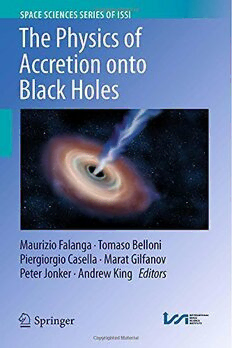
The Physics of Accretion onto Black Holes PDF
Preview The Physics of Accretion onto Black Holes
SPACE SCIENCES SERIES OF ISSI The Physics of Accretion onto Black Holes Maurizio Falanga · Tomaso Belloni Piergiorgio Casella · Marat Gilfanov Editors Peter Jonker · Andrew King 123 Space Sciences Series of ISSI Volume 49 Forfurthervolumes: www.springer.com/series/6592 Maurizio Falanga (cid:2) Tomaso Belloni (cid:2) Piergiorgio Casella (cid:2) Marat Gilfanov (cid:2) Peter Jonker (cid:2) Andrew King Editors The Physics of Accretion onto Black Holes Previously published in Space Science Reviews Volume 183, Issues 1–4, 2014 Editors MaurizioFalanga MaratGilfanov InternationalSpaceScienceInstitute MaxPlanckInstituteforAstrophysics Bern,Switzerland Garching,Germany TomasoBelloni PeterJonker TheNationalInstituteofAstrophysics NetherlandsInstituteforSpaceResearch Merate,Italy Utrecht,TheNetherlands PiergiorgioCasella AndrewKing TheNationalInstituteofAstrophysics UniversityofLeicester Rome,Italy Leicester,UK ISSN1385-7525 SpaceSciencesSeriesofISSI ISBN978-1-4939-2226-0 ISBN978-1-4939-2227-7(eBook) DOI10.1007/978-1-4939-2227-7 SpringerNewYorkHeidelbergDordrechtLondon LibraryofCongressControlNumber:2014952460 ©SpringerScience+BusinessMediaNewYork2015 Thisworkissubjecttocopyright.AllrightsarereservedbythePublisher,whetherthewholeorpartofthe materialisconcerned,specificallytherightsoftranslation,reprinting,reuseofillustrations,recitation,broad- casting,reproductiononmicrofilmsorinanyotherphysicalway,andtransmissionorinformationstorage andretrieval,electronicadaptation,computersoftware,orbysimilarordissimilarmethodologynowknown orhereafterdeveloped.Exemptedfromthislegalreservationarebriefexcerptsinconnectionwithreviews orscholarlyanalysisormaterialsuppliedspecificallyforthepurposeofbeingenteredandexecutedona computersystem,forexclusiveusebythepurchaserofthework.Duplicationofthispublicationorparts thereofispermittedonlyundertheprovisionsoftheCopyrightLawofthePublisher’slocation,initscur- rentversion,andpermissionforusemustalwaysbeobtainedfromSpringer.Permissionsforusemaybe obtainedthroughRightsLinkattheCopyrightClearanceCenter.Violationsareliabletoprosecutionunder therespectiveCopyrightLaw. Theuseofgeneraldescriptivenames,registerednames,trademarks,servicemarks,etc.inthispublication doesnotimply,evenintheabsenceofaspecificstatement,thatsuchnamesareexemptfromtherelevant protectivelawsandregulationsandthereforefreeforgeneraluse. Whiletheadviceandinformationinthisbookarebelievedtobetrueandaccurateatthedateofpublication, neitherthe authors nor theeditors nor the publisher canacceptanylegalresponsibility for anyerrors or omissionsthatmaybemade.Thepublishermakesnowarranty,expressorimplied,withrespecttothematerial containedherein. Coverillustration:ArtistimpressionofanaccretingblackholebyH.Flinterman(StudioWW15)&SRON, NetherlandsInstituteforSpaceResearch. Printedonacid-freepaper SpringerispartofSpringerScience+BusinessMedia(www.springer.com) Contents Foreword (cid:3) M.Falanga L.Stella 1 (cid:3) SearchingforBlackHolesinSpace TheKeyRoleofX-RayObservations K.Pounds 5 GeneralOverviewofBlackHoleAccretionTheory O.Blaes 21 FastVariabilityfromBlack-HoleBinaries (cid:3) T.M.Belloni L.Stella 43 ModellingSpectralandTimingPropertiesofAccretingBlackHoles:TheHybridHot FlowParadigm (cid:3) J.Poutanen A.Veledina 61 CurrentStatusofSimulations P.C.Fragile 87 ObservationalTestsofthePictureofDiskAccretion T.J.Maccarone 101 ObservationalAppearanceofBlackHolesinX-RayBinariesandAGN (cid:3) M.Gilfanov A.Merloni 121 ScalingRelationsfromStellartoSupermassiveBlackHoles E.Körding 149 MenusforFeedingBlackHoles (cid:3) B.Kocsis A.Loeb 163 MassiveBinaryBlackHolesinGalacticNucleiandTheirPathtoCoalescence M.Colpi 189 MassMeasurementsofStellarandIntermediate-MassBlackHoles (cid:3) J.Casares P.G.Jonker 223 MeasuringtheMassesofSupermassiveBlackHoles B.M.Peterson 253 MeasuringBlackHoleSpinUsingX-RayReflectionSpectroscopy C.S.Reynolds 277 BlackHoleSpinviaContinuumFittingandtheRoleofSpininPoweringTransient Jets (cid:3) (cid:3) J.E.McClintock R.Narayan J.F.Steiner 295 AnOverviewofJetsandOutflowsinStellarMassBlackHoles (cid:3) R.Fender E.Gallo 323 (cid:3) X-RayObservationsofPowerfulAGNOutflows ImplicationsforFeedback K.Pounds 339 OutflowLaunchingMechanisms (cid:3) K.Ohsuga S.Mineshige 353 EnergeticandBroadBandSpectralDistributionofEmissionfromAstronomicalJets A.Pe’er 371 Jet–EnvironmentInteractionsasDiagnosticsofJetPhysics S.Heinz 405 TheSupermassiveBlackHole—GalaxyConnection A.King 427 (cid:3) Multi-WavelengthVariability AccretionandEjectionattheFastestTimescales (cid:3) P.Uttley P.Casella 453 BlackHoleStudies:OverviewandOutlook T.J.Maccarone 477 About the Editors Professor Maurizio Falanga is the Science Program Manager at the International Space Sci- enceInstitute.Hisresearchareasincludehigh-energyastrophysics,observationsandnumerical simulations. ProfessorTomasoBelloniisaseniorscientistatINAF’sBreraAstronomicalObservatory.Heis anexpertinX-rayastronomy,accretingsourcesandtimeseriesanalysis. Dr.PiergiorgioCasellaisanastronomeratINAF’sRomeAstronomicalObservatory.Heisan expertinhigh-energyastrophysics,accretionandjetphysics. ProfessorMaratGilfanovisaseniorscientistattheMaxPlanckInstituteforAstrophysics.His researchareasincludetheoreticalandobservationalastrophysics,blackholesandgalaxies. ProfessorPeterJonkerisanastronomeratSRON.Heisanexpertinhigh-energyastrophysics andobservations. ProfessorAndrewKing isaseniorscientistattheUniversityofLeicester.Heisanexpertin theoreticalastrophysics,accretion,blackholesandgalaxies. DOI10.1007/978-1-4939-2227-7_1 ReprintedfromSpaceScienceReviewsJournal,DOI10.1007/s11214-014-0044-8 Foreword MaurizioFalanga·LuigiStella Publishedonline:16April2014 ©SpringerScience+BusinessMediaDordrecht2014 Blackholeswerepredictedlongbeforethebeginningofthespaceage;theywereperceived asby-productsofmathematicaltheories,existedonlyintheimaginationofafewscientists. Theideaof“darkstars”(theyweredubbed“blackholes”onlyin1968)canbetracedback tothelate18thcentury,whenJohnMichell(Englishphilosopherandgeologist)andsome yearslatertoPierre-SimonLaplace(Frenchmathematicianandastronomer)speculatedthat, ifaplanetorastarweredenseenough,theirescapevelocitywouldequalthespeedoflight. Lightparticles(photons)leavingthesurfaceofsuchaworld,wouldrise,stop,andthenfall back down like projectiles do. This “Newtonian” view of black holes, while conceptually interesting, is not an adequate description of what happens to light near a massive dense body. By the end of the 19th century strong evidence had been found that the speed of light isauniversalconstant,whichremainsthesameinanyreferenceframe.Byexploitingthe constancyofthespeedoflightandtheprincipleofrelativity(statingthatthelawsofphysics shouldremainthesameinanyinertialreferenceframe)inapplicationtoMaxwell’sequa- tionsofelectromagnetism,AlbertEinsteindevelopedin1905anewtheory(theTheoryof SpecialRelativity)thatledtoadeeprevisionoftheconceptsofspaceandtime:contraryto simpleintuition,spaceandtimeintervalsdonotremainunchangedforobserversinmotion withrespecttooneanother. Afteradecadeofattempts,Einsteinsucceededinformulatingatheorygravity(andelec- tromagnetism) obeying the general principle of Relativity, i.e. that physical laws are the sameinallreferenceframes(inertialornon-inertial).Einstein’sbasicconceptwastodrop Newton’s idea of a force (the gravitational force) that is responsible for the attraction of masses.Inplaceofthathewasguidedbyofwhathedefinedthe“happiestthoughtofhis life”: that the effects of gravity are cancelled in a body that accelerates because it falls M.Falanga(B) InternationalSpaceScienceInstitute(ISSI),Hallerstrasse6,3012Bern,Switzerland e-mail:[email protected] L.Stella INAF—OsservatorioAstronomicodiRoma,ViaFrascati,33,MonteporzioCatone,Rome00040,Italy 1 Reprintedfromthejournal M.Falanga,L.Stella freely, no matter what the body is. Stated differently, acceleration can mimic gravity and, vice-versa, gravity can mimic acceleration: that is the “Equivalence principle”. By using themathematicalinstrumentofdifferentialgeometry,Einsteinformulatedanewtheory,the TheoryofGeneralRelativity,inwhichgravitationandmotionofbothmatterandlightre- sultfromthegeometricpropertiesofspace-time(ratherthanNewton’sattractionforce).In turn the geometry of space-time, the matter and light in particular, determine its varying curvature. Some solutions of Einstein’s equations of General Relativity predict that a sufficiently compactmasswillcurvespace-timesuchmuchthatnothing,notevenlight,canescapefrom inside a critical surface, the so-called event horizon: that provided the modern foundation oftheblackholeconcept.Accordingtotheso-called“NoHairTheorem”stationaryblack holesarecompletelycharacterizedbyonlythreeobservables:mass,angularmomentumand electriccharge(thelatterbeingirrelevantinastrophysicalblackholes).Allotherinformation (forwhich“hair”isametaphor)aboutthematterwhichformedtheblackhole(orfellinto itafterformation)islostbehindtheeventhorizon,andremainspermanentlyinaccessibleto externalobservers. Since the early seventies, a wealth of observational evidence has been found for the presenceofblackholesintheuniverse.Whilenothingcanescapefromtheeventhorizon, theregionsinitsimmediatesurroundings(thatis,say,tensoftimesthehorizonradius)can become veryluminousand launch jetsat speedsclosetothespeed oflight.Thishappens whenmatterflowstowardstheblackholeandreleasesup∼40%ofitsrestmassenergyin theprocess.This“accretion”energy,mightbesupplementedbytheextractionofpartofthe blackhole’srotationalenergy. Stellarmassblackholes(4–15solarmasses)inbinarysystemsarebeingdiscoveredin increasingnumbersintheMilkyWayandnearbygalaxies.Super-massiveblackholes,from millionstobillionsolarmasses,existinthecentreofmostifnotallgalaxies;theradiation they release when they are active deeply influences the evolution of their hosts. Though relativelyquiescent,the∼4millionsolarmassblackholeinthecentreofourMilkyWayis oneofthebeststudiedandoffersverygoodprospectsfordirectimagingofthe“shadow” causedbylightbendinginthevicinityoftheeventhorizon. Blackholesareideallaboratoriesforstudyingbothphysicalpropertiesofaccretiononto compact objects and probing the effects of General Relativity in the strong field regime. Theseextremephenomenaareinaccessibletolaboratoryexperiments.Throughobservations athighenergies(mainlyintheX-rays)andmultiwavelengthprogramsspanningthewidest rangeoftheelectromagneticspectrum,fromtheradiotoTeVenergies),ourknowledgeof astrophysicalblackholeshasadvancedconsiderablyoverthelasttwodecades.Diagnostics have emerged which can directly probe the dynamics of matter motion very close to the blackhole,wherethestrongfieldgeneralrelativisticeffectsbecomeimportant.Atthesame time,considerableprogresshasbeenmadedevelopingadvancedmodelsandunderstanding the physicsof accretion ontocompact objects.Yet, a number of keyissuesremain poorly understood.Forinstancetheinterpretationanddecompositionoftheenergyspectraofac- cretingblackholesarestillmuchdebated.Similarly,differentcompetingmodelsarebeing investigatedwhichexplainatleastpartofthevariabilitypropertiesofblack. Thisbookispresentsacollectionofreviewsofastrophysicalblackhole.Thefirstsection of the contains very valuable introductory material about the history of the first observed blackhole.Thesecondsectiondescribesthephysicalmodelsfortheaccretionflowaround blackholesofallmasses,wherethethirdandfourthsectionsdescribetheaccretiononblack holesfromstellarmasstosupermassiveanditsfundamentalparameters.Thefifthsectionis devotedtotheaccretion-jetinterplay,whilethelastsectionreportsanoverviewandoutlook ofblackholeresearch. Reprintedfromthejournal 2
